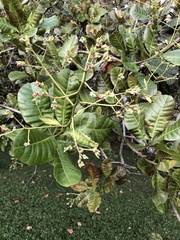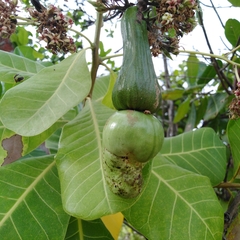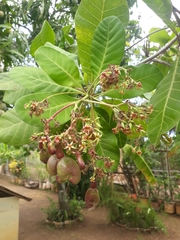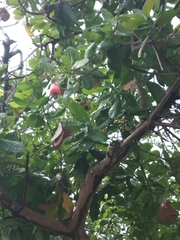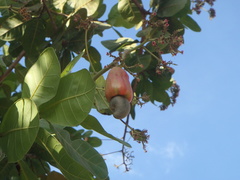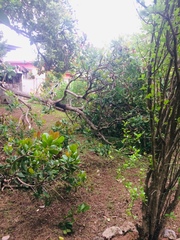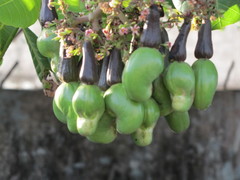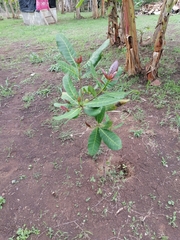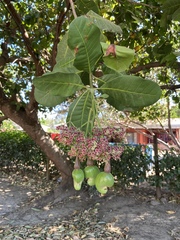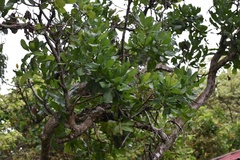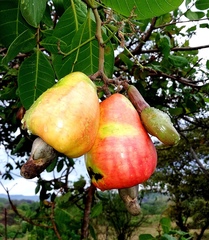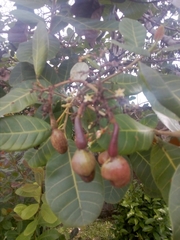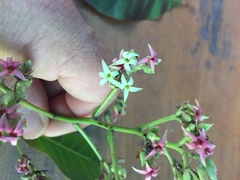

|
|
|
|
Family: Anacardiaceae
Cashewnut, more...cashew (es: Marañón)
[Anacardium microcarpum Ducke] |
Description: A small tree, with a leaning trunk branching close to the ground. Foliage is dense throughout crown, usually reaching almost to the ground. Leaves are short and oval, have yellow central vein and secondary veins. Most trees have quite a few red leaves. Reproduction: Flowers are tiny, in loose clusters above the leaves, small petals are pinkish, produced in the late wet season. Fruits are green, shaped like a kidney, with the edible nut attached to a larger fleshy portion, produced ____. Distribution: Seen only on farmland and in towns, throughout Panama. Often planted, but grows on its own as well. Never seen in the forest. Native to the American tropics, but its original distribution is obscured now as it has been transported everywhere by people. Similar Species: In its grassland and farm habitat, the species most similar to the cashew is LK curaam Curatella americana LK2 in the Dilleniaceae. It is usually distinguished from the cashew by its lack of red leaves. The cashew has a close relative that is common in the Canal area, the wild cashew or espavé, LK anacex Anacardium exelsum. LK2 Fruits of the two species are very similar, but the cashew has shorter, blunter leaves. The most important difference is the trees' form - the espavé grows tall and straight, while the cashew is always short, usually with a leaning and often-branched trunk. Uses: Both fruit and nut are widely eaten throughout the world. Descripción: Árbol de 5 a 12 m de alto. Copa redondeada. Tronco irregular y ramificado a baja altura. Corteza exterior negra o gris. Corteza interior roja. El desprendimiento de ramas o heridas en el tronco producen una savia resinosa y aromática, la cual se torna roja o negra con el transcurrir del tiempo. Hojas simples y alternas, de 6-24 x 3-10 cm, oblongas a obovadas, con ápice redondeado o emarginado, bordes enteros y base decurrente. Las hojas se encuentran agrupadas en los extremos terminales de las ramitas, y cuando están nuevas a veces son de color rojo. Pecíolo de 0.5-2.5 cm de largo y pulvinado en la base. Flores verdes, amarillentas o rosadas, aromáticas. Frutos en nueces arriñonadas, de 2-3.5 cm de largo, verdes, tornándose grises al madurar. Los frutos presentan un pedúnculo engrosado (hipocarpo), verde, madurando de color rojo o amarillo. Datos Ecológicos: La especie crece a bajas y medianas elevaciones, en lugares secos o húmedos. Cultivada y naturalizada en todo el país. Común en áreas secas y lugares abiertos con suelos rojos y degradados de la provincia de Coclé. Florece y fructifica de enero a mayo. Las flores son visitadas por abejas, mariposas y colibríes. Especies Parecidas: A menudo se confunde con LK anacex Anacardium excelsum LK2 , pero A. excelsum es un árbol de mayor tamaño. También se puede confundir con LK curaam Curatella americana LK2 , pero C. americana tiene hojas ásperas al tacto. Usos: Cultivada por el valor nutritivo y comercial de sus frutos (nueces). Los pedúnculos maduros son comestibles, se emplean para fabricar refrescos y helados. La nuez tiene un aceite llamado cardol, el cual es irritante y cáustico, ocasiona fuertes irritaciones al contacto con la piel, se usa para quemar verrugas y los granos ocasionados por la leishmaniasis. El tronco exuda una resina que se emplea como goma. La corteza se utiliza para curar diarreas, disenterías, infecciones de la garganta, hemorragias y cicatrizar heridas, también para curtir pieles. Small cultivated tree, usually to 8 m tall and 25-30 cm dbh; branches roughened somewhat with prominent lenticels. Leaves simple, alternate; petioles 1-1.5 cm long; blades obovate, rounded to emarginate at apex, mostly acute at base, 6-16 cm long, 4.5-8 cm wide, glabrous; midrib and major lateral veins impressed and paler above, raised and paler below, the reticulate veins obscure. Panicles terminal; flowers bisexual, pedicellate, 5-parted, fragrant, puberulent on exposed parts outside; calyx lobes sharp; petals reflexed at about middle, sharply lobed, 1-2 mm wide, white to reddish near middle at anthesis, otherwise greenish; stamens 10, 1 much longer, exserted, the shorter ones held about midway in tube formed by recurved petals, often of different lengths, sometimes sterile; anthers occasionally with one theca held higher than the other; filaments fused near base; style 1, minute; nectar collecting both within ring of petals and between petals and sepals. Nuts reniform, 2-3.5 cm long, violet-purple to brown, borne at apex of an obovate, bright red, edible, fleshy hypocarp (the accrescent pedicel); mesocarp thin; seed l. Croat 6917. Cultivated at the Laboratory Clearing. Flowers from November to May (sometimes from October). The fruits mature from April to July (sometimes from December). Native to the American tropics, but cultivated throughout the tropics. In Panama, known principally from tropical moist forest in the Canal Zone (both slopes), Chiriqui, Veraguas, Los Santos, Herrera, Panama, and Darién; known also from tropical dry forest in Panama (Taboga Island), from premontane wet forest in Colón, Chiriqui, and Panama, and from premontane moist forest in Panama. Bocas Species Database Habitat: The cashew tree will grow ideally on well-drained sandy soils with at least 900 mm of rainfall annually. This tree can tolerate conditions that are too dry or too poor for other crops. It can grow well in soils with a pH of 4.5 to 6.5. Distribution: The cashew tree is native from the southeast zone of Brazil. However, it is now cultivated in all tropical countries where one or two dry seasons occur and produced commercially in more than 32 countries. Here are some countries that actively cultivate cashews: India, Nigeria, Viet Nam, Brazil and Indonesia. Natural History Notes: The cashew tree is native from the southeast zone of Brazil. The Portuguese discovered it in 1578 and introduced it to the India and East Africa in the 16th century. The cashew tree was used at first to reduce erosion in India, but later on, people realized the great potential to exploit the cashew of the tree for the nut and the cashew “apple”. The cashew “apple” was the first product to be commercialized. The nut trade started later, in the 1920s, when people in South America realized that if the nut were roasted, the caustic oil was removed and the nut could be cracked and eaten without any problem. This tree is now cultivated in all tropical countries where one or two dry seasons occur. India has been the first country to develop an international cashew nut trade and was the number 1 produced until very recently. The top 5 producers are now Viet Nam, Nigeria, India, Brazil and Indonesia. The cashew culture occupies more than 7.5 million acres of land in the world. Characteristics: The cashew tree can reach a height of approximately 5 to 12 m. It is an evergreen that has simple and alternate leaves that group in the terminal extremities of the branches. Young leaves are sometimes reddish in color, flowers are green or yellowish. The fruit of the cashew is a nut in the shape of a kidney that is attached to a bigger part called "apple", that is often mistaken for the fruit; it is in fact the edible receptacle and the fruit stalk. The nut is green colored but eventually turns gray as the fruit ripens. When it reached maturity, the fruit falls from the tree and is picked up by hand. Afterward, the nuts are dried in the sun and then roasted. Afterwards, the nuts are shelled by hands or by specialized machines. Notes: This species is cultivated for the nutricional and commerical value of its fruits (nuts). The fleshy fruit is edible and is used to make refreshments and ice creams. The "apple" is rich in vitamin C and is also diuretic. The nut contains an oil called cardol, which is highly irritable to the skin but used to burn off warts and leishmaniasis scars. The trunk of the tree contains a resin which is used as glue. The bark is used to cure diarrhea, dysenteries, throat infections, hemorrhage and open wounds, also used to toughen animal skins. |



















